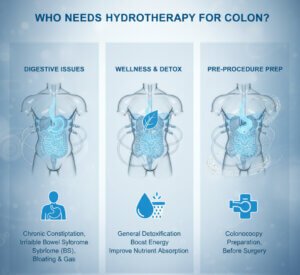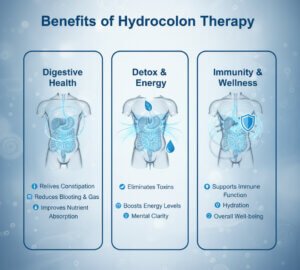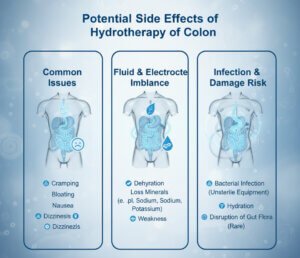
Reading Time: 6 minutes
Hydrocolon Therapy Procedure Guide.
Hydrocolon therapy, also known as colon hydrotherapy or colonic irrigation, is a modern cleansing method that involves flushing the large intestine (colon) with warm, filtered water to remove waste, toxins, and mucus.
It has gained popularity as a natural detoxification method and a complementary therapy for digestive health.
This article covers the **entire process, indicative conditions, contraindications, and post-care guidelines**, along with details on cost and effectiveness in India.
What Is Hydrocolon Therapy?
Hydrocolon therapy is a **non-surgical, water-based colon cleansing procedure** performed under the supervision of a trained therapist.
The technique uses controlled infusions of warm, purified water into the colon through a small sterile tube inserted into the rectum.
The water circulates through the large intestine, helping to soften and dislodge waste material, which is then evacuated through a closed drainage system.
It differs from a simple enema — which cleans only the lower part of the bowel — as hydrocolon therapy cleanses the entire colon (ascending, transverse, and descending sections) using repeated gentle water infusions.
Process of Hydrocolon Therapy
Step 1: Pre-Procedure Assessment
Hydrocolon Therapy Procedure Guide. Before the session, the therapist conducts a brief medical evaluation to rule out contraindications such as inflammatory bowel disease, recent surgery, or pregnancy.
The goal is to ensure the colon is safe for irrigation and the patient understands the potential effects.
Step 2: Preparation and Positioning
The patient is asked to lie comfortably on a therapy table, typically on their left side or supine position.
Disposable gowns and sterile equipment are used to maintain hygiene and privacy.
Lubricant is applied before inserting a narrow plastic speculum approximately 1–2 inches into the rectum.
Step 3: Water Infusion
A specialized hydrotherapy machine pumps **filtered, temperature-controlled warm water (around 37°C)** into the colon.
The water’s gentle pressure helps loosen fecal matter, gas pockets, and mucus accumulated on the colon wall.
Step 4: Massage and Evacuation
As water fills the colon, the therapist performs **gentle abdominal massage** to aid release.
The used water and debris are drained through a closed tubing system directly into a waste line—maintaining odor-free and contamination-free disposal.
Step 5: Repetitive Cycles
This process is repeated several times during the session, each infusion followed by drainage. A typical session lasts **35–45 minutes**, and approximately **15–25 liters of water** may pass through the colon within a single treatment.
Step 6: Post-Treatment
After the therapy, patients are allowed to rest for a few minutes and may use the restroom to expel any remaining water or gas.
A probiotic or electrolyte drink is often recommended immediately after to restore the body’s natural flora and fluid balance.
Duration and Frequency
Most practitioners recommend **a series of 4–6 sessions** spaced over 2–3 weeks to achieve optimal results.
The frequency depends on the individual’s health condition, dietary habits, and digestive issues.
Charges for Hydrocolon Therapy in India
The cost of hydrocolon therapy varies depending on city, clinic reputation, and inclusion of supplements:
| Location / Clinic Type | Cost Per Session (INR) | Duration | Notes |
|———————–|————————|———–|——-|
| Metro cities (Delhi, Mumbai, Bengaluru) | ₹4,000 – ₹6,000 | 40–45 minutes | Premium spas and holistic health centers |
| Tier 2 cities (Ahmedabad, Pune, Kochi) | ₹3,000 – ₹4,500 | 30–40 minutes | Certified wellness centers |
| Ayurvedic or naturopathy institutes | ₹2,500 – ₹3,500 | Varies | Often combined with detox diet & massage |
| Professional package (5–6 sessions) | ₹20,000 – ₹30,000 | Over 3 weeks | Includes dietary guidance and probiotic therapy |
On average, the total treatment plan price ranges from **₹25,000 to ₹35,000**, depending on the number of sessions and extent of post-procedural care.
Indications for Hydrocolon Therapy

Hydrocolon therapy is usually sought for **detoxification, constipation management, and digestive health improvement**.
It may also serve as adjunctive therapy for metabolic and dermatologic conditions. Clinical evidence is still evolving, yet practitioners often recommend it for specific cases.[7][8][3]
Common Indications
– **Chronic constipation** unresponsive to dietary changes or mild laxatives
– **Bloating and flatulence** caused by intestinal gas accumulation
– **Irritable bowel syndrome (IBS)** with sluggish bowels
– **Skin conditions** such as acne, eczema, and psoriasis triggered by gut toxins
– **Halitosis (bad breath)** due to poor elimination
– **Fatigue and lethargy**, often linked with toxin buildup in the colon
– **Weight loss programs**, especially before detox diets or bariatric care
– **Preparation before colonoscopy** or abdominal surgery in certain medical setups
– **Detoxification therapy** in naturopathy and wellness centers
– **Post-antibiotic dysbiosis**, to restore healthy gut flora
***
Contraindications of Hydrocolon Therapy
While hydrocolon therapy is safe for most healthy adults when done properly, it **should not be performed in several medical conditions**. Contraindications fall under absolute and relative categories.[9][4][7]
Absolute Contraindications
– **Inflammatory bowel diseases**: Ulcerative colitis, Crohn’s disease, diverticulitis
– **Colorectal cancer or recent biopsy/surgery** (<6 months post-op)
– **Rectal bleeding or fissures**
– **Severe hemorrhoids or anal tear**
– **Pregnancy** (any trimester)
– **Congestive heart failure or severe hypertension**
– **Severe anemia, renal failure, or hepatic decompensation**
– **Recent radiotherapy** to abdominal or pelvic area
– **Uncontrolled diarrhoea or intestinal perforation risk**
– **Anticoagulant therapy** (e.g., Warfarin, Clopidogrel)[4]
Relative Contraindications
– Controlled hypertension under medication
– Mild hemorrhoids without bleeding
– Chronic fatigue or moderate heart disease
– Post-chemotherapy (must be supervised)
– Recent laparoscopic surgery (less than 6 weeks)[4]
A medical evaluation is mandatory before scheduling the procedure, particularly for patients on long-term medication or with known gastrointestinal ##
Benefits of Hydrocolon Therapy

Though results vary between individuals, properly administered hydrocolon therapy may offer several physiological and psychological benefits:
– **Improves bowel regularity** by stimulating peristalsis.
– **Relieves bloating, heaviness, and gas** symptoms.
– **Enhances nutrient absorption** by clearing mucoid plaque.
– **Supports liver detoxification** by reducing intestinal toxin reabsorption.
– **Improves hydration** and mineral balance due to water circulation.
– **Boosts energy and mood**, linked to reduced intestinal load.
– **Aids weight loss** by improving digestion and gut motility.
– **Promotes clear skin** and a sense of well-being due to detox effects.[3][1][2]
***
Potential Side Effects

Common minimal side effects include **abdominal cramping, mild nausea, or temporary fatigue** immediately after the session. Rarely, improper technique may cause **bowel perforation, electrolyte imbalance, or infection**, emphasizing the need for certified and sterile setups only.[3]
Home Care After Hydrocolon Therapy
Hydrocolon Therapy Procedure Guide. Proper aftercare is essential to sustain the digestive balance and prevent any discomfort. Post-procedure, the body is in a sensitive state requiring hydration, microbial restoration, and dietary regulation.[10][11][12][13]
1. Immediate 24-Hour Care
– **Hydrate adequately**: Drink at least 8–10 glasses of water per day. Coconut water or electrolyte drinks restore fluid balance.
– **Avoid dehydration**: Refrain from caffeine, alcohol, and carbonated drinks.
– **Rest**: Take it easy for a few hours if you feel lightheaded or tired.
– **Replace probiotics**: Use probiotic supplements or natural options like curd, kefir, or yogurt drinks.
– **Gentle diet**: Prefer soups, steamed vegetables, rice gruel, and herbal teas. Avoid spicy or heavy meals.[12][10]
2. Diet Guidelines for Following Days
1. **Eat fiber-rich foods**: Include fruits, oats, and whole grains to maintain bowel movement.
2. **Avoid processed and oily foods**: They can burden the freshly cleansed colon.
3. **Consume fermented foods**: Kimchi, kombucha, or buttermilk help replenish beneficial bacteria.
4. **Include fluids**: Green juices, herbal teas, or lemon water promote ongoing detoxification.
5. **Stop refined sugar temporarily**, as it may upset the gut’s bacterial balance.[13][12]
Lifestyle Advice
– **Do not plan strenuous activities** immediately after therapy.
– **Practice deep breathing or light yoga** to ease abdominal tension.
– **Warm baths with Epsom salt** help relax muscles and assist detox.
– **Massage abdomen gently** clockwise to relieve bloating or trapped gas.
– **Monitor bowel function**: Normal pattern returns within 1–3 days. If constipation develops, increase fiber and water intake.[14][12]
***
Medical and Wellness Recommendations
Colon hydrotherapy should be considered **complementary**, not a substitute for medical treatment. Consultation with a gastroenterologist is advised if symptoms like bleeding, persistent pain, or altered bowel pattern occur post-therapy. Patients with prior abdominal surgery or chronic illness should always undergo procedure only under medical supervision.[4][3]
***
Myths and Misconceptions
– **Myth 1**: “Colon hydrotherapy permanently cleans your body.”
*Reality:* Detox is temporary; continued healthy diet and hydration are necessary.
– **Myth 2**: “It’s equivalent to an enema.”
*Reality:* An enema cleanses only the lower part of the colon, while hydrotherapy reaches higher segments.
– **Myth 3**: “Home colon kits are safe and cheap.”
*Reality:* At-home kits carry risk of contamination and perforation and should be avoided.
Conclusion
Hydrocolon Therapy Procedure Guide. Hydrocolon therapy offers a powerful yet gentle way to **enhance digestive health, relieve constipation, and support detoxification**. When performed by a trained specialist in hygienic settings, it promotes improved digestion, clearer skin, and increased vitality. However, **it must be carefully selected**, considering medical contraindications and supervised for safe outcomes.
For lasting results, pair it with **a high-fiber diet, probiotic support, hydration, and regular physical activity**. Hydrocolon therapy is a wellness tool—not a cure—and works best as part of an integrated lifestyle plan aimed at balanced gut health and better well-being.
